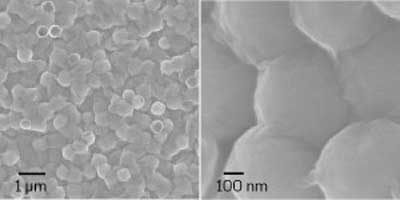| Posted: Nov 16, 2017 |
Unleashing nano sulfur's potential
(Nanowerk News) Hollow sulfur nanospheres wrapped inside sheets of molybdenum disulfide could form the ideal cathode material for the next generation of lithium-ion batteries, research from A*STAR suggests (JACS, "In situ observation and electrochemical study of encapsulated sulfur nanoparticles by MoS2 flakes").
|
|
The amount of energy a lithium-ion battery can hold is partly determined by the amount of lithium ions its cathode can absorb. Sulfur’s high chemical affinity for lithium ions means a lithium-sulfur battery could hold five times the energy of today’s lithium-ion batteries.
|
 |
| Scanning electron microscopy image showing a sheet of the MoS2-wrapped sulfur nanoparticles. (© ACS)
|
|
Sulfur does have drawbacks, however. Once ‘lithiated’, it becomes soluble in the battery’s electrolyte, and so can break away from the cathode. Sulfur also swells by up to 80 per cent when soaking up lithium. Both processes shorten the cathode’s life.
|
|
Complicating matters, the process by which sulfur absorbs lithium is hard to study in situ. Sulfur has a high vapor pressure, which means that its atoms rapidly sublime under the high vacuum conditions required for imaging techniques, such as transmission electron microscopy.
|
|
With an initial aim of getting a better look at sulfur during lithiation, Guangyuan Wesley Zheng from the A*STAR Institute of Materials Research and Engineering co-led an international effort to seal sulfur nanoparticles inside sheets of a 2D nanomaterial to suppress sublimation. The team selected nanoflakes of molybdenum disulfide (MoS2), a material known to have a good binding interaction with sulfur and lithium sulfide, to encase the particles.
|
|
The researchers were then able to examine the nanoparticles using transmission electron microscopy. “The most significant insight we gained related to the ‘lithiation kinetics’ of sulfur particles,” Zheng says. “We observed relatively fast lithium reaction kinetics — quite a surprise, as the common understanding is that sulfur is highly insulating, and it is difficult to directly lithiate sulfur particles.”
|
|
As well as gaining fundamental insights into lithium’s interaction with sulfur, the team showed the MoS2-wrapped hollow sulfur nanoparticles could become more than just a study tool. Sealing the sulfur within MoS2 restricted the damaging volume change and the loss of lithiated sulfur into the electrolyte, avoiding the two key hurdles blocking the use of sulfur in lithium-ion batteries.
|
|
“I do believe there is practical application for the technique in batteries, if we can further improve the MoS2 production process,” Zheng says. “We are currently exploring the scaled-up production of the encapsulated sulfur particles, and working with a battery company to develop a commercial prototype battery,” he says.
|

